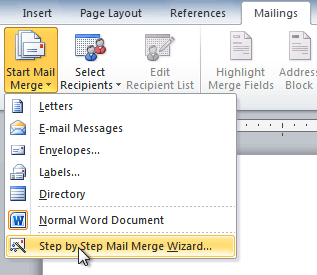
Items in the task pane or by clicking buttons in the Write & Insert Fields group on the Mailings tab. Then insert the required merge fields in the main document, either by clicking

If necessary, in the Select Table dialog box, click the table you want to use as your data source, and then click OK.Then in the Select Data Source dialog box, identify the data source, and click Open. With the Using an existing list option selected, click Browse.

With the Use the current document option selected, click Next: Select recipients.In the Mail Merge task pane, with the Letters option selected, at the bottom of the pane, click Next: Starting document.On the Mailings tab, in the Start Mail Merge group, click the Start Mail Merge button, and then click Step by Step Mail Merge Wizard.Create a document containing the text of the letter.To set up mail merge for letters by using the Mail Merge wizard The Mail Merge wizard guides you through the process of merging a main document and a data source. For more info, see Set up a mail merge list with Word.Setting Up a Mail Merge by Using the Mail Merge Wizard Word data file is a data source you can create on the fly, within Word. See Use Outlook contacts as a data source for a mail merge Outlook Contact List contains data in a format that can be read by Word. For more info, see Prepare your data source in Excel for a mail merge in Word for Mac. Excel spreadsheets and Outlook contact lists are the most common data sources, but if you don't yet have a data source, you can type it up in Word, as part of the mail merge process.Įxcel spreadsheet works well as a data source if all data is on one sheet and the data is formatted so that it can be read by Word. Your first step in setting up a mail merge is to pick the source of data you'll use for the personalized information. This type of document is also called a catalog merge.Ĭreate a directory of names, addresses, and other information Use it to print out your contact list, or to list groups of information, like all of the students in each class. You'll be sending the email directly from Word.Įnvelopes or Labels where names and addresses come from your data source.Ĭreate and print a batch of envelopes for mailingĬreate and print sheets of mailing labelsĭirectory that lists a batch of information for each item in your data source. Each letter prints on a separate sheet of paper.Ĭreate and print a batch of personalized lettersĮmail where each recipient's address is the only address on the To line. Letters that include a personalized greeting.

Follow the links for details about each type: Word provides tools for incorporating your data into the following kinds of documents. Use Outlook contacts as a data source for a mail merge If you know you'll be using Excel or Outlook as the source of your data, see: If you don't yet have a data source, you can even type it up in Word, as part of the mail merge process.įor details about data sources, see Data sources you can use for a mail merge. Excel spreadsheets and Outlook contact lists are the most common data sources, but any database that you can connect to Word will work.


 0 kommentar(er)
0 kommentar(er)
